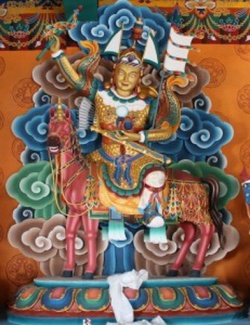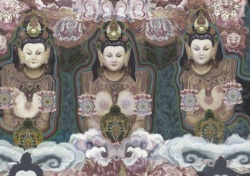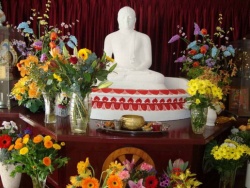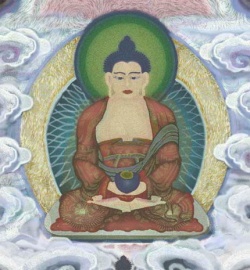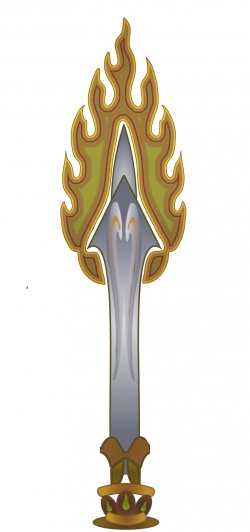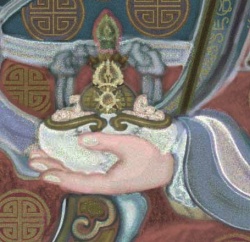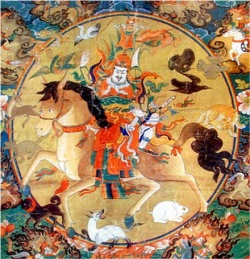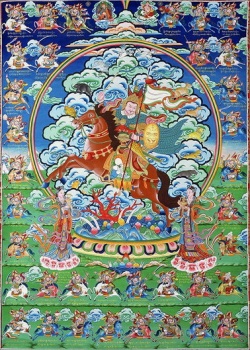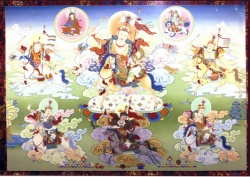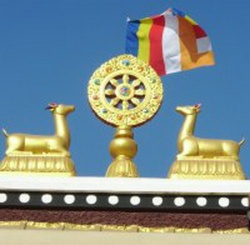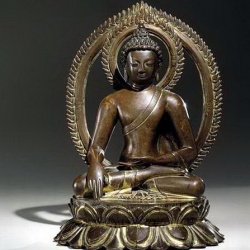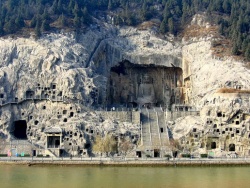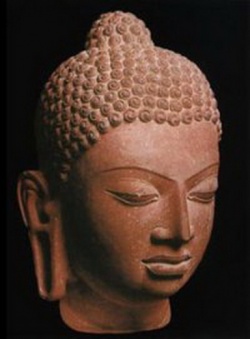King Gesar Ling
The Epic of King Gesar (pron.: /ˈɡɛzər/ or /ˈɡɛsər/; Standard Tibetan: གེ་སར་རྒྱལ་པོ, Ge-sar rGyal-po, "King Gesar"; Mongolian: Гэсэр Хаан, Geser Khan, "King Geser"), also spelled Geser (especially in Mongolian contexts) or Kesar (/ˈkɛzər/ or /ˈkɛsər/), is an epic cycle, believed to date from the 12th century, that relates the heroic deeds of the culture hero Gesar, the fearless Lord of the legendary kingdom of Ling (Standard Tibetan: gLing). It is recorded variously in poetry and prose, chantfable being the style of traditional performance, and is sung widely throughout Central Asia. Its classic version is to be found in central Tibet. Some 100 bards of this epic (sgrung: lit."tale") are still active today in the Gesar belt of China, Tibetan, Mongolian, Buryat, and Tu singers maintain the oral tradition and the epic has attracted intense scholarly curiosity as one of the few oral epic traditions to survive as a performing Art. Besides stories conserved by such Chinese minorities such as the Bai, Naxi, the Pumi, Lisu, and the Yugur peoples, versions of the epic are also recorded among the Burushaski-speaking Burusho of Hunza and Gilgit the Kalmyk and Ladakhi peoples, in Baltistan, in Sikkim, Bhutan, Nepal, and among various Tibeto-Burmese, Turkish, and Tunghus tribes. The first printed version was a Mongolian text published in Beijing in 1716.
The epic is composed of a very large Body of versions, each with many variants, and is reputed by some to be the longest in the world. Although there is no one definitive text, the Chinese compilation so far of just its Tibetan versions has filled some 120 volumes, more than one million verses, divided into 29 "chapters". Western calculations speak of more than 50 different Books edited so far in China, India and Tibet.
A Tibetan scholar has written:
Like the outstanding Greek epics, Indian epics and Kalevala, King Gesar is a brilliant pearl in the world's cultural treasure and is an important contribution made by our country to human civilization
Etymology of the name and origin of the epic
Etymology
It has been proposed on the basis of phonetic similarities that the name Gesar reflects the Roman title Caesar, and that the intermediary for the transmission of this imperial title from Rome to Tibet may have been a Turkish Language, since kaiser (emperor) entered Turkish through contact with Byzantium, where Caesar (Καῖσαρ) was an imperial title. Some think the medium for this transmission may have been via Mongolian Kesar. The Mongols were allied with the Byzantines, whose emperor still used the title. Numismatic evidence and some accounts speak of a Bactrian ruler Phrom-kesar, specifically in the Turkish dynasty in Gandhāra, which was ruled by a Turkish Phrom-kesar ("Caesar of Rome"), who was father-in-law of the king of Khotan, around the middle of the 8th century CE. In early Bön sources, Phrom-kesar is always a place name, and never refers, as it does later, to a ruler. In some Tibetan versions of the epic, a king named Phrom Ge-sar or Khrom Ge-sar figures as one of the kings of the four directions – the name is attested in the 10th century and this Phrom/Khrom preserves an Iranian form (*frōm-hrōm) for Rūm/Rome. This eastern Iranian word lies behind the Middle Chinese word for (Eastern) Rome (拂菻:Fúlǐn), namely Byzantium (phrōm-from<*phywət-lyəm>).
A. H. Francke thought the Tibetan name Gesar derived from Sanskrit. S.K. Chatterji, introducing his work, noted that the Ladakh variant of Kesar, Kyesar, in Classical Tibetan Skye-gsar meant 'reborn/newly born', and that Gesar/Kesar in Tibetan, as in Sanskrit signify the 'anther or pistil of a flower', corresponding to Sankrit kēsara, whose root 'kēsa' (Hair) is Indo-European.
Gesar and the Kingdom of Ling
In Tibet, that Gesar was an historical figure is rarely questioned. Some scholars there argued he was born in 1027, on the basis of a note in a 19th-century chronicle, the Mdo smad chos vbyung by Brag dgon pa dkon mchog bstan pa rab. Certain core episodes seem to reflect events recorded at the dawn of Tibetan history: the marriage to a Chinese princess is reminiscent of legends concerning Srong-btsan sGam-po's alliance marriage with Wénchéng in 641, for example. Legends variously place him in Gulok, between Dotō and Domé, or in Markham, Kongpo, Tanak, Öyuk or the village of Panam on the Nyangchu river. Given that the mythological and allegorical elements of the story defy place and time, the historicity of figures in the cycle is indeterminate. Though the epic was sung all over Tibetan-speaking regions, with Kham and Amdo long regarded as the centres for its diffusion, traditions do connect Gesar with the former Kingdom of Ling (Standard Tibetan: gLing). In Tibetan, gling means, literally, an 'island', but can have, as in Sanskrit dvīpa), the secondary meaning of 'continent'. Ling was a petty kingdom located in the eastern part of the Tibetan plateau (Tibetan: mdo khams), between the 'Bri (Yangtze) and rDza (Yalong) rivers. An historical kingdom of Lingtsang (Tibetan: gLing-tshang) existed until the 20th century.
Growth of the Epic
The success of the Turk Fromo Kesaro in overwhelming an intrusive Arab army, sometime between 739-745, may have formed the historic core behind the Gesar epic in Tibet. In the records of the earliest rulers of Ladakh, Baltistan and Gilgit, whose countries were later overrun by incursive Tibetans, royal ancestry is connected to the Bactrian Gesar.
In its distinctive Tibetan form, the epic appears to date from the time of the second transmission of Buddhism to Tibet (marked by the formation of the Kadampa, Kagyu and Sakya schools), although the story includes early elements taken from Indian tantricism. The oral tradition of this epic is most prominent in the two remote areas associated with the ancient Bönpo (Ladakh and Zanskar in the far west of Tibet, and Kham and Amdo regions of eastern Tibet), strongly suggesting that the story has Bön roots. However, the oral versions known to us today are not, according to R. A. Stein, earlier than the written versions, but rather depend on them.
As an oral tradition, a large number of variants have always existed, and no canonical text can be written. However, the epic narrative was certainly in something similar to its present form by the 15th century at the latest as shown by the mentions in the rLangs-kyi Po-ti bSe-ru by Byang chub rgyal mtshan. Despite the age of the tradition, the oldest extant text of the epic is actually the Mongolian woodblock print commissioned by the Qing Emperor Kangxi in 1716. None of the Tibetan texts that have come down to us are earlier than the 18th century, although they are likely based on older texts that have not survived. In the late 19th and early 20th centuries a woodblock edition of the story was compiled by a scholar-Monk from Ling-tsang, a small kingdom north-east of sDe-dge, with inspiration from the prolific Tibetan philosopher Jamgon Ju Mipham Gyatso.
The wide variety of cultures in which the Gesar epic is encountered means that the name for the hero varies.In Tibetan legends Gesar is variously called Gesar of Ling, Ling Gesar, Gesar Norbu Dradul. Among the Buryat he is known as Abai Gesar Khubun. The Khalkha oral version calls him Altan Bogdo khan. An Altai version calls him Sädängkäi Käsär and Sartaktai Käsär,
Story and narrative motifs
The epic has a vast number of variants in plot and motifs, but while there is little point in looking for a consistent picture, the core of the story, similar to that of many legendary cycles, has been summed up as follows:
King Ge-sar has a miraculous birth, a despised and neglected childhood, and then becomes ruler and wins his (first) wife ’Brug-mo through a series of marvellous feats. In subsequent episodes he defends his people against various external aggressors, human and superhuman. Instead of dying a normal Death he departs into a hidden realm from which he may return at some time in the future to save his people from their enemies.
For Samuels, the Gesar epic lies towards the shamanic pole in the continuum of Tibetan culture and religion, which he sees as evincing a constant tension between 'clerical' and 'shamanic' Buddhism, the latter grounded in its earlier Bön substrate. The received versions of the Ge-sar cycle are thickly overlaid with Buddhist ideas and motifs, and detecting the original 'heroic' form is difficult. Historical analysis to sift out an ancient core narrative winnows the archaic folkloric leitmotifs from features that show distinct and historically identifiable Buddhist influences. Samuel, comparing three Gesar traditions, Mongolian, Eastern Tibetan and Ladakhi, that developed relatively autonomously, postulates the following core narrative shared by all three:
(1) The Lha gling episode.
(2) The ′Khrungs gling episode.
(3) The rTa rgyugs episode.
(4) The bDud 'dul episode.
(5) The Hor gling episode.
(6) The China journey episode.
to which one might add
(7) The Srid pa'i le'u cosmogenic prelude.
Tibetan versions
Tibetan versions differ very greatly in details. Often Buddhist motifs are conspicuous, with episodes on the creation of the world and Tibet's cosmic origins. In other variants The Buddha is never mentioned, or a certain secular irony is voiced against the national religion. According to Samten Karmay, Gesar arose as the hero of a society still thinly permeated by Buddhism, and the earlier myths associate him with pre-Buddhist beliefs like the mountain cult. While in most episodes, Gesar fights against the enemies of Dharma, an old warrior ethos, where physical Power, courage, a combative spirit and things like cunning and deceit, prevail.
Cosmic prelude and Tibet's early history. One motif explains how the world collapsed into anarchy: numerous demon kings (Tib.:bdud) had avoided subjection. As a result, hordes of cannibalistic demons and goblins, led by malignant and greedy rulers of many kingdoms, wreak havoc. Tibet's Conversion from barbarity to Buddhism under the three great Dharma kings (Sanskrit:Dharma rāja/Tibetan: chos rgyal) often feature. Episodes relate how Padmasambhāva (Tib.: pad-ma 'byung gnas) subdued Tibet's violent native spirits.
His miraculous or mundane birth. In one account, he was fatherless, like Padmasambhāva, who assists his celestial creation by creating a nāgī who then serves the king of Ling, and is impregnated by drinking a magic potion, and is born from his mother's head, like Athena. Or, he is conceived by his mother drinking water impressed with his image. Alternatively, he is born from the union of a father who is simultaneously skygod and holy mountain, and of a mother who is a goddess of the watery underworld, or he is born, Chori, in the lineage of Ling in the Dza Valley, to the king Singlen Gyalpo and his spouse Lhakar Drönma of Gog.
Relatives. He has a half-brother, and two uncles: one is the "old hawk", (Tib.:sPyi dPon rong tsha), the wise elder of Ling,who supports the child; the other, the cowardly and greedy Khro-thung, sees the child as a threat and tries to do him ill. Khro-thung fulfils a comic role in the epic, but his role as provocateur is absolutely central.
His early years. Gesar's mission as a divine emissary is to vanquish powerful demons on earth. Until his adolescence he is depicted as black, ugly, nasty, snotty and troublesome. His paternal uncle, or the king's brother Todong, banishes both son and mother to the Ma (Tib.:rMa) plateau, where he grows up living a feral Life, with the child clothed in animal skins and wearing a hat with antelope horns. He comes first in a horserace whose trophy consists of the kingship of Ling. His victory marks his coming of age, as consecrated king, he proclaims himself 'the Great Lion, Wish.-fulfilling Jewel, Subduer of Foes' (Tib.: Sengchen Morbu Dradul). He also assumes the name of Gesar. Mounted on his miraculous steed Kyang Go Karkar, he subsequently wages military campaigns, together with 30 companions, against the frontier countries that represent Evil.
Horserace and kingship. When he is 12, a horse race is held to determine who will become the king of Ling and who will marry the beautiful daughter, 'Brug-mo, of a neighbouring chieftain. Returning to Ling, Chori wins the race, marries 'Brug-mo, and ascends the golden throne. He thenceforth assumes the title 'Gesar'.
The kidnapping of 'Brug-mo. His first campaign as king is against Klu-btsan, the man-eating demon of the north. While away, his wife is kidnapped by Gur-dkar (literally: "white tent"), the King of Hor. On his return, Gesar undertakes a second compaign, and uses magic to infiltrate the king of Hor's palace, kills him and retrieves his wife.
two further campaigns. Gesar wages war against King Sa-dam of 'Jang (sometimes located in Yunnan), and king Shing khri of Mon (sometimes located in the southern Himalayan region).
The 18 fortresses (rdzong chen bco brgyad). Gesar sets out to conquer the 18 great forts (Tib.: rdzong). They are listed differently according to singers and texts, but these battles nearly always include Tajik (Tib.: Stag-gzig) and Khache Muslim adversaries.
Lhasa. Some versions say that, aged 39 he made a retreat on the 'Red Hill' (Marpori), where the later Potala Palace was built.
Old age. When Gesar reaches his eighties, he briefly descends to Hell as a last episode before he leaves the land of men and ascends once more to his celestial paradise.
Mongolian version (1716) version
Opens with a heavenly prologue, Ge-ser's birth, youth, marriage to Rogmo and his obtaining the kingship of Ling.
Geser defeats a black striped tiger.
Geser's voyage to China where he marries a Chinese princess
Geser's defeat of the demon king, with the help of the latter's wife.
Geser's war against the three kings of Sharaigol (Hor)
Geser's defeat of a demon who assumed the guise of a Lama.
Geser's descent to hell to rescue his mother.
Buryat version
Buryat versions of the epic focus mainly on Gesar's battles with various demons, rather than on military campaigns They also contain a detailed and drastically different prologue to Gesar's exploits. According to these versions, the great Tengri Khormusta (Turmas, Khorbustu, Hormust) khan of the celestial tribes of the West waged war with Atai Ulan, khan of the malicious gods of the east. After his victory, Khormusta dismembers Atai Ulan to prevent his resurrection and throws his Body parts to Earthe they become demons and monsters. The act almost causes the extinction of humanity, the middle son of Khormusta (Bukhe Belligte or Uile Butelegcji) was sent from the realm of Heaven to undo the damage.
The Buryat version contains 9 branches or song episodes ( uliger), each devoted to tell how Gesar defeats an enemy.
First branch:Gesar's youth. In this branch, Gesar, called Nyurgai (Stinker) and while still in his infancy, defeats three giant rats, human-sized mosquitos and steel ravens (compare Heracles and Cu Chulain) and marries two princess, whereupon he assumes his true name.
Second branch: He marries princess Alma Mergen, daughter of a water deity. He then hunts demonic beasts, born from Atai Ulan's drops of blood. These include a mountain-sized dragon, the keeper of a silver mountain.
Third branch: He undertakes combat with the great Lord of the Taiga, the giant tiger Orgoli, which was born from Atai Ulan's right hand.
Fourth branch: He kills a great beast, Arkhan the Sun-Eater, who was born from Atai Ulan's severed head.
Fifth branch: He wars against Gal Dulme, the personification of volcanic activity, who was born from Atai Ulan's corpse. Because of his youth Gesar is unable to defeat Gal Dulme by himself, and the deed is performed with assistance from his elder brother.
Sixth branch: He wars against Abarga Sasen, a 15-headed demon born from Atai Ulan's right leg.
Seventh branch: He wars against Shiram Minata, a Demon from the 'Country betwixt Life and Death', who was born from Atai Ulan's left leg.
Eighth branch: He wages war against three Shirai-Gol khans. This branch seems to be closely related to the Tibetan song about Gesar and three kings of kingdom of Hor.
Ninth branch: He campaigns against Lobsogoi, a trickster demon, who was born from Atai Ulan's backside.
There are a number of stories not connected with the foregoing nine branches described above for example, a story in which Gesar shames Gume-Khan of China, or one in which he exterminates the Four Recklings of Evil, demonic beings whose nature is not quite clear.
Distinctive features of these versions of the Gesar epic has led some scholars to the view that the Buryat and Mongolian versions are not directly dependent on a Tibetan original. Setsenmunkh has argued, and the idea was shared by C. Damdinsuren and B. Vladimirtsev, that the written Mongolian versions stem from one source which has not survived.
Lower Ladakhi version
This version contains the following seven episodes:
The ancestor Dong-gsum Mi-la sngon-mo, born miraculously, kills a nine-headed ogre, from whose Body the land of gLing is born. He fathers eighteen heroes who arrive in gLing.
dBang-po rgya-bzhin, choses his youngest son, Don-grub to rule gLing. Dying, he is reborn as a bird, and then as Gog-bzang lha-mo, and is called Kesar/Kyesar.
Kesar married Brug-gu-ma ('a fragment of grain') and becomes king of gLing.
Kesar journeys to China where he marries the emperor's daughter, 'g.Yu'i dKon-mchog-ma.
Kesar defeats the giants of the north, assisted by the giant's wife Dze-mo.'
While he is away, the King of Hor kidnaps his wife 'Brug-gu-ma.
On his return, Kesar vanquishes the King of Hor, and brings his wife back to gLing.
Salar version
The Salar Language is used to recite some portions of Gesar.
Similarities with motifs in Turkic heroic poetry
Chadwick and Zhirmunsky consider that the main outlines of the cycle as we have it in Mongolia, Tibet and Ladakh show an outline that conforms to the pattern of heroic poetry among the Turkic peoples. (a) Like the Kirghiz hero Bolot, Gesar, as part of an initiation descends as a boy into the underworld. (b) The gateway to the underworld is through a rocky hole or cave on a mountain summit. (c) He is guided through the otherworld by a female tutelary spirit (Manene/grandmother) who rides an animal, like the Turkish shamaness kara Chach. (d) Like kara Chach, Gesar's tutelary spirit helps him against a host of monstrous foes in the underworld. (e) Like Bolot, Gesar returns in triumph to the world, bearing the Food of immortality and the water of Life.(f) Like the Altai shamans, Gesar is borne heavenward on the back of a bird to obtain herbs to heal his people. They conclude that the stories of the Gesar cycle were well known in the territory of the Uyghur Khaganate.
The Bhutan versions
The versions of the Gesar epic collected in Bhutan, in publication since 1979, are projected to run into some 31 volumes.[64][65] The Second King of Bhutan retained a Gesar singer as a full-time entertainer for the royal court, and recitals of the Epic of Gesar were said to be the king's favorite form of edification.
Oral transmission and performance
According to Lǐ Liánróng,
By narrowing the period of its creation to the tenth and eleventh centuries, the dynamic of literary composition is erroneously attributed to an oral epic. Furthermore, the epic reflects Tibetan society during the sixth to ninth centuries rather than the tenth century. Thus a satisfactory conclusion about the epic’s origins cannot be drawn based on the lifespans of historical heroic figures.... Jiangbian pointed out that the foundation for the origin of epic is ethnic folk culture. He conjectured that before epics came into being, the Tibetan people “already had a corpus of stories that described the formation of the heavens and the earthr ethnic origin, and ethnic heroes; these stories provided a foundation for creating the character Gesar, also known as Sgrung in early history. After further polishing by the oral poets, especially the ballad singers, Gesar became a great epic” (1986:51).
Many performers recite episodes from memory or Books, while others chant the legendary tales in a state of trance. This last mode bears strong similarities with shamanic practitioners like the dpa'bo mediums and mig mthong diviners. As an heroic song composed or recited by oral bards, the epic of Gesar has been, for centuries, improvised on, and there is therefore no canonical or monumental version, as one finds in, for example, Greek epic. A given Gesar singer would know only his local version, which nonetheless would take weeks to recite. It has been responsive to regional culture and folklore, local conflicts, religious trends, and even political changes on the world stage. For example, in modern times, when news of World War II trickled into Tibet, additional episodes on how 'Gesar Conquers the Kingdom of Phyigling 'Jar' were composed by Khams-sprul Rinpoche VIII (1929–1980) in which Gesar appears, according to some interpretations, to travel to Germany to vanquish the demon-king, perhaps alluding to Hitler.
Religious dimension
Tibetan history has often swung between centralized and stateless poles, and the epic of Gesar reflects the tensions between central authority, as embodied in religious orthodoxy, and the wild, nomadic forces of the autarkic periphery. There are versions that adopt Gesar as a Lama showing him as a tamer of the wild, but, in so far as his epic retains his old lineaments as a maverick master of shamanic powers, he represents the stateless, anarchic dimension of Tibet's margins, and is rather a tamer of corrupt monastic clerics and, thus, it is not coincidental that the epic flourished on the outlying regions of Kham and Amdo. His wars are campaigns of defence against hostile powers intent on subduing the kingdom of gLing, which are often construed as anti-Buddhist. But his vanquishing of the dzongs or fortresses preserves an ambiguity, since these were potential outposts of the state.
Until recently, the tale was forbidden reading in many Tibetan monasteries. In some monasteries, however, rituals invoking Gesar as a major spiritual force are performed. Given the central role the epic played over the centuries in Tibetan folk culture, Tibetan Buddhism has incorporated elements from it and interpreted them in religious terms. The Gelugpa school disapproved of the epic, while Kagyupa and Nyingmapa lamas generally favoured it, seeing it as an expression of the activity of Guru Rinpoche and as a vehicle for Buddhist teachings, especially of the Dzogch'en school. Consequentially, the question of whether babdrung (visionary Gesar bards) should be regarded as ch'öpa (Dharma people) will be answered differently by those who favor and those who oppose the epic. The babdrung themselves, however, generally emphasize the connection of the epic with ch'ö (Dharma) and see themselves as a kind of ch'öpa or Dharma practitioner.
Orgyen Tobgyal Rinpoche recently explained that in the Nyingmapa perspective:
'the real nature of the manifestation we know as Ling Gesar is actually that of Guru Rinpoche himself appearing in the form of a drala.'
Chogyam Trungpa Rinpoche, who represented both the Kagyupa and Nyingmapa lineages, and leader of the modern Eclectic School (Ris-med) of Tibetan Buddhism in the diaspora, inspired by the Greek philosophers of the polis, used the Gesar epic detailed tales about an idealized nomadic government formed by the Mukpo clan, which constructed a nomadic confederation of imperial reach, to develop a model of a Tibetan polity.
History of Gesar studies
The first printed edition of the Gesar epic was published in Beijing in 1716 in a Mongolian version. It was this text which formed the basis for the first Western-Language translation, a Russian version published by the Moravian missionary Isaak Jakob Schmidt in 1836 A German translation followed in 1839. Another Moravian missionary, August Hermann Francke, collected and translated a version from Lower Ladakh between 1905 and 1909. In 1942 George Roerich made a comprehensive survey of the literature of Gesar (Roerich 1942;277-315)
In the 20th century, other Mongolian Geser texts were edited by scientists like Nicholas Poppe and Walther Heissig.
The first three volumes of the version known as the Lingtsang-Dege woodblock, which was composed in the late 19th and early 20th centuries, was published with a very faithful though incomplete French translation by Rolf Stein in 1956. Stein followed this publication with his 600-page magnum opus on the Tibetan Epic entitled Recherches sur l'Epopee et le Barde au Tibet.[80] This remains the most in-depth study of the Tibetan Gesar tradition.
Another version has been translated into German by Matthias Hermanns (1965). This translation is based on manuscripts collected by Hermanns in Amdo. This book also contains extensive study by Hermanns explaining the epic as the product of the Heroic Age of the nomads of North-eastern Tibet and their interactions with the many other peoples of the Inner Asian steppe. Hermanns believed the epic to pre-date Buddhism in Tibet, and saw in it an expression of the ancient Tibetan archetype of the "Heaven-sent king", as found also in the myths of the founders of the Yarlung Dynasty, who founded the Tibetan Empire (7th-9th centuries CE).
The most accessible rendering of Gesar in English is by Alexandra David-Néel in her "Superhuman Life of Gesar of Ling", published in French in 1933.
